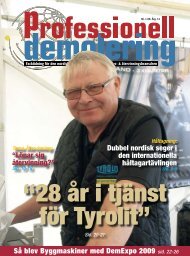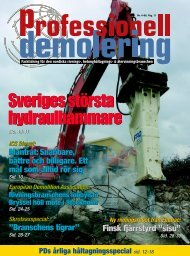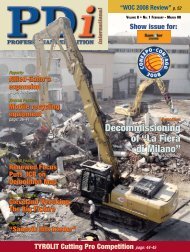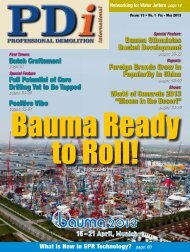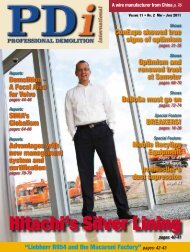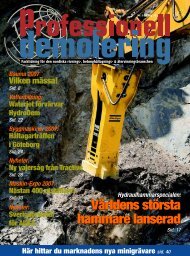Demolition In UAE! pages: 38-40 - Pdworld.com
Demolition In UAE! pages: 38-40 - Pdworld.com
Demolition In UAE! pages: 38-40 - Pdworld.com
Create successful ePaper yourself
Turn your PDF publications into a flip-book with our unique Google optimized e-Paper software.
Words from O’Brien<br />
Silica - Wet<br />
versus Dry<br />
Sawing<br />
<strong>In</strong> 2004, the U.S. Occupational Safety and<br />
Health Administration (OSHA) proposed new<br />
regulations for exposure to respirable silica in<br />
the construction industry. A reduction of the<br />
Permissible Exposure Limit (PEL) level from 1.0<br />
to 0.25 was proposed, but many felt that this<br />
proposal showed a lack of understanding on<br />
the part of regulators concerning the impact this<br />
standard would have on small businesses.<br />
The proposed standard would have required<br />
construction <strong>com</strong>panies to initiate many<br />
new procedures. For example, an industrial<br />
hygienist hired by the contractor would be<br />
required to provide sampling services on each<br />
and every site. The contractor would also have<br />
to designate a “<strong>com</strong>petent person” to identify<br />
and evaluate silica exposure hazards, establish<br />
a perimeter and constantly monitor the quality<br />
of the air. The contractor would have to<br />
make respirators and Tyvek clothing available<br />
to workers as well as anyone entering the<br />
job site including trades working in adjacent<br />
areas. Medical screening and exam costs for<br />
employees would skyrocket. Record-keeping<br />
costs to <strong>com</strong>ply would drive administrative<br />
expenses up.<br />
The proposed new regulations were never<br />
enacted by OSHA and it may have been due<br />
to feedback they received from the OSHA<br />
Small Business Advocacy Review (SBAR)<br />
Panel or other feedback they received. The<br />
panel presented documentation that showed<br />
the estimated cost to a small business of<br />
$12,000 would have actually been close to<br />
$3 million and put many small businesses<br />
out of work. CSDA was active in working with<br />
special survey<br />
other associations to propose an alternative<br />
“control banding” approach. Under this proposal,<br />
operators would arrive on the job, and<br />
based upon the type of sawing or drilling to be<br />
performed and whether it would be inside or<br />
outside, they would have a simple chart to let<br />
them know what type of filter or mask would<br />
be required, if any.<br />
Since that time, CSDA has continued to<br />
collect airborne silica data on the different<br />
cutting operations. We invited the National<br />
<strong>In</strong>stitute of Occupational Safety and Health<br />
(NIOSH) to our training sessions to examine<br />
the silica exposure for operators. Based upon<br />
the fact that a typical CSDA cutting contractor<br />
performs cutting operations wet over 95%<br />
of the time the exposure dangers are greatly<br />
minimized as confirmed by NIOSH. Cutting pros<br />
have traditionally cut wet to extend the blade or<br />
bit life of the diamond tool, but the secondary<br />
benefit is to almost eliminate operator exposure<br />
to respiratory silica.<br />
However, those contractors who have<br />
traditionally cut dry face a different challenge.<br />
Manufacturers have been active in developing<br />
dust collection systems to control and minimize<br />
the exposure to crystalline silica. So whether<br />
the contractor is cutting wet or dry, it would<br />
appear that industry is proactively responding<br />
to this threat to operator health even in the<br />
absence of new government regulations. This<br />
speaks very highly of the industry, both manufacturers<br />
and contractors, and is a testament<br />
to their <strong>com</strong>mitment to providing a safe work<br />
environment for their operators.<br />
Best regards<br />
Patrick O’Brien<br />
Executive Director CSDA,<br />
US Concrete Sawing<br />
& Drilling Association<br />
Thank you Denis!<br />
On the afternoon of 9 July 2009, Trevi<br />
Benne’s representative in the Caribbean<br />
Islands Mr Denis Clément, passed away after a<br />
long illness. Trevi Benne’s marketing manager,<br />
Christian Tadiotto told PDi that he will leave a<br />
big gap. “He was a very <strong>com</strong>petent distributor<br />
since for many years for Trevi Benne. Full of<br />
spirit and energy, always eager to learn and<br />
ask questions. And he was also a very dear<br />
and good friend and he really loved his job,”<br />
says Christian.<br />
Christian adds that his spirit and passion<br />
for his job remain within Trevi Benne and he<br />
has made a strong footprint among his colleagues.<br />
PDi editor Jan Hermansson had the<br />
pleasure to meet Denis less then a year ago<br />
and an article about him and his <strong>com</strong>pany was<br />
published in PDi issue 1-2009.<br />
New Finmac<br />
appointment<br />
Mr. Jaakko Lipsanen has joined Finmac<br />
<strong>Demolition</strong> Oy to be in charge of business<br />
development. Previously Mr Lipsanen had a<br />
career of over 20 years with Rammer (presently<br />
Sandvik Breakers) in Lahti, Finland.<br />
Finmac is a Finnish <strong>com</strong>pany designing<br />
and manufacturing high-quality remotely<br />
controlled robots used primarily in demolition<br />
and various process industry applications. The<br />
<strong>com</strong>pany is based on the innovations of the<br />
owner, Mr. Paavo Salonen. Finmac is located in<br />
Vaasa, a town in the west coast of Finland.<br />
www.finmac.fi<br />
HTC appoints new<br />
President and CEO<br />
HTC Sweden AB has appointed Lars Landin<br />
as the new President and CEO of HTC<br />
Group from first of October. Lars Landin,<br />
who in recent years has worked as Sales<br />
and Marketing Director at HTC.<br />
Since HTC Sweden AB began in 1987,<br />
HTC has developed into the world’s leading<br />
manufacturer and supplier of <strong>com</strong>plete<br />
grinding and maintenance systems for<br />
floors. Today the group has almost 170<br />
employees, with the vast majority employed<br />
within the technology and product development<br />
department, as well as manufacturing<br />
and sales. The head office is based in<br />
Söderköping, Sweden, and subsidiaries<br />
operate in USA, Germany, UK and France.<br />
The <strong>com</strong>pany’s products are sold mainly in<br />
Europe, USA, Middle East and Asia.<br />
“HTC has had remarkable growth<br />
but there is still a huge potential for the<br />
<strong>com</strong>pany to develop further and we shall<br />
do so by continuing to offer our customers<br />
the very best flooring solutions,” says<br />
Lars Landin.<br />
HTC’s resigning CEO, and also the<br />
<strong>com</strong>pany’s principal owner Håkan Thysell<br />
has chosen to focus on development and to<br />
continue protecting HTC’s many patents.<br />
“It is a pleasure for me to hand over<br />
the post as President and CEO to Lars<br />
Landin and I wish him all the best,” says<br />
Håkan Thysell.<br />
Background<br />
Lars Landin is 45 years old, and since 2007<br />
has worked as the Sales and Marketing<br />
Director at HTC with responsibility for all<br />
markets and product areas. Lars came to<br />
HTC after 11 years as Sales Director of the<br />
packaging <strong>com</strong>pany Rostiprimpac AB which<br />
is a part of A.P. Möller Group.<br />
www.htc-floorsystems.<strong>com</strong><br />
8 PDi • Is s u e 3 - 2009 • Au g - Se p t




